One-Pot Synthesis and Enhanced Vis-NIR Photocatalytic Activity of NiTiO3/TiO2 Templated by Waste Tobacco Stem-Silks
Abstract
1. Introduction
2. Materials and Methods
2.1. Chemicals and Materials
2.2. Treatment of Tobacco Stem-Silks
2.3. Synthesis of NiTiO3/TiO2 (TSS)
2.4. Characterization of the Prepared Photocatalysts
2.5. Photocatalytic Activity
3. Results and Discussion
3.1. Synthesis and Photocatalysts Characterizations
3.2. Photocatalytical Degradation of Tetracycline
3.3. Plausible Mechanism of Photocatalytic Oxidation of Tetracycline
3.4. Transformation Products of Tetracycline
4. Discussion
Supplementary Materials
Author Contributions
Funding
Data Availability Statement
Conflicts of Interest
References
- Yu, J.; Ran, J. Facile Preparation and Enhanced Photocatalytic H2-Production Activity of Cu(OH)2 Cluster Modified TiO2. Energy Environ. Sci. 2011, 4, 1364–1371. [Google Scholar] [CrossRef]
- Qu, Y.; Duan, X. Progress, Challenge and Perspective of Heterogeneous Photocatalysts. Chem. Soc. Rev. 2013, 42, 2568–2580. [Google Scholar] [CrossRef]
- Shen, J.; Luo, C.; Qiao, S.; Chen, Y.; Tang, Y.; Xu, J.; Fu, K.; Yuan, D.; Tang, H.; Zhang, H.; et al. Single-Atom Cu Channel and N-Vacancy Engineering Enables Efficient Charge Separation and Transfer between C3N4 Interlayers for Boosting Photocatalytic Hydrogen Production. ACS Catal. 2023, 13, 6280–6288. [Google Scholar] [CrossRef]
- Schneider, J.; Matsuoka, M.; Takeuchi, M.; Zhang, J.; Horiuchi, Y.; Anpo, M.; Bahnemann, D.W. Understanding TiO2 Photocatalysis Mechanisms and Materials. Chem. Rev. 2014, 114, 9919–9986. [Google Scholar] [CrossRef]
- Pelaez, M.; Nolan, N.T.; Pillai, S.C.; Seery, M.K.; Falaras, P.; Kontos, A.G.; Dunlop, P.S.M.; Hamilton, J.W.J.; Byrne, J.A.; O’Shea, K.; et al. A Review on the Visible Light Active Titanium Dioxide Photocatalysts for Environmental Applications. Appl. Catal. B Environ. 2012, 125, 331–349. [Google Scholar] [CrossRef]
- Yang, P.; Zhang, Q.; Zhang, Y.; Zhang, H.; Zhao, J.; Shi, H.; Liang, L.; Huang, Y.; Zheng, Z.; Yang, H. Aggregation Triggers Red/Near-Infrared Light Hydrogen Production of Organic Dyes with High Efficiency. ACS Catal. 2023, 13, 3723–3734. [Google Scholar] [CrossRef]
- Li, J.; Wang, J.; Zhang, G.; Li, Y.; Wang, K. Enhanced Molecular Oxygen Activation of Ni2+-Doped BiO2−x Nanosheets under UV, Visible and near-Infrared Irradiation: Mechanism and DFT Study. Appl. Catal. B Environ. 2018, 234, 167–177. [Google Scholar] [CrossRef]
- Sun, P.; Li, K.; Liu, X.; Wang, J.; Qiu, X.; Wei, W.; Zhao, J. Peptide-Mediated Aqueous Synthesis of NIR-II Emitting Ag2S Quantum Dots for Rapid Photocatalytic Bacteria Disinfection. Angew. Chemie-Int. Ed. 2023, 135, e202300085. [Google Scholar] [CrossRef]
- Liu, W.; Zhang, H.; Wang, H.-g.; Zhang, M.; Guo, M. Titanium Mesh Supported TiO2 Nanowire Arrays/Upconversion Luminescence Er3+-Yb3+ Codoped TiO2 Nanoparticles Novel Composites for Flexible Dye-Sensitized Solar Cells. Appl. Surf. Sci. 2017, 422, 304–315. [Google Scholar] [CrossRef]
- Zheng, Z.; Tachikawa, T.; Majima, T. Single-Particle Study of Pt-Modified Au Nanorods for Plasmon-Enhanced Hydrogen Generation in Visible to near-Infrared Region. J. Am. Chem. Soc. 2014, 136, 6870–6873. [Google Scholar] [CrossRef] [PubMed]
- Tang, Y.; Di, W.; Zhai, X.; Yang, R.; Qin, W. NIR-Responsive Photocatalytic Activity and Mechanism of NaYF4:Yb,Tm@TiO2 Core-Shell Nanoparticles. ACS Catal. 2013, 3, 405–412. [Google Scholar] [CrossRef]
- Zhao, J.; Liu, C.; Wang, H.; Fu, Y.; Zhu, C.; Huang, H.; Liao, F.; Liu, Y.; Shao, M.; Kang, Z. Carbon Dots Modified WO2-NaxWO3 Composite as UV-Vis-NIR Broad Spectrum-Driven Photocatalyst for Overall Water Splitting. Catal. Today 2020, 340, 152–160. [Google Scholar] [CrossRef]
- Wei, D.; Yao, L.; Yang, S.; Cui, Z.; Wei, B.; Cao, M.; Hu, C. Band Gap Engineering of In2TiO5 for H2 Production under Near-Infrared Light. ACS Appl. Mater. Interfaces 2015, 7, 20761–20768. [Google Scholar] [CrossRef] [PubMed]
- Dai, B.; Fang, J.; Yu, Y.; Sun, M.; Huang, H.; Lu, C.; Kou, J.; Zhao, Y.; Xu, Z. Construction of Infrared-Light-Responsive Photoinduced Carriers Driver for Enhanced Photocatalytic Hydrogen Evolution. Adv. Mater. 2020, 32, 1906361. [Google Scholar] [CrossRef] [PubMed]
- Zhang, Z.; Wang, W. Infrared-Light-Induced Photocatalysis on BiErWO6. Dalton Trans. 2013, 42, 12072–12074. [Google Scholar] [CrossRef] [PubMed]
- Wang, L.; Xu, X.; Cheng, Q.; Dou, S.X.; Du, Y. Near-Infrared-Driven Photocatalysts: Design, Construction, and Applications. Small 2021, 17, 1904107. [Google Scholar] [CrossRef] [PubMed]
- Inceesungvorn, B.; Teeranunpong, T.; Nunkaew, J.; Suntalelat, S.; Tantraviwat, D. Novel NiTiO3/Ag3VO4 Composite with Enhanced Photocatalytic Performance under Visible Light. Catal. Commun. 2014, 54, 35–38. [Google Scholar] [CrossRef]
- Pham, T.T.; Shin, E.W. Thermal Formation Effect of G-C3N4 Structure on the Visible Light Driven Photocatalysis of g-C3N4/NiTiO3 Z-Scheme Composite Photocatalysts. Appl. Surf. Sci. 2018, 447, 757–766. [Google Scholar] [CrossRef]
- Mi, L.; Huang, Y.; Qin, L.; Seo, H.J. Improved Photo-Degradation of Dyes over Ag-Loaded NiTiO3:V Nanorods on Visible-Light-Irradiation. Mater. Res. Bull. 2018, 102, 269–276. [Google Scholar] [CrossRef]
- Zhao, G.-y.; Zhang, Y.; Jiang, L.; Zhang, H.-m. NiTiO3/Ag3PO4 Composites with Improved Photocatalytic Activity under Visible-Light Irradiation. Ceram. Int. 2017, 43, 3314–3318. [Google Scholar] [CrossRef]
- Li, B.; Wang, W.; Zhao, J.; Wang, Z.; Su, B.; Hou, Y.; Ding, Z.; Ong, W.J.; Wang, S. All-Solid-State Direct Z-Scheme NiTiO3/Cd0.5Zn0.5S Heterostructures for Photocatalytic Hydrogen Evolution with Visible Light. J. Mater. Chem. A 2021, 9, 10270–10276. [Google Scholar] [CrossRef]
- Liu, C.; Zhu, X.; Wang, L.; Feng, C.; Rong, J.; Li, Z.; Xu, S. Construction of NiTiO3/g-C3N4 heterojunction with preferable photocatalytic performance for tetracycline degradation. J. Solid State Chem. 2024, 339, 124953. [Google Scholar] [CrossRef]
- Ahmad, M.I.; Liu, Y.; Wang, Y.; Cao, P.; Yu, H.; Li, H.; Chen, S.; Quan, X. Enhanced Photocatalytic Synthesis of Urea from co-Reduction of N2 and CO2 on Z-Schematic SrTiO3-FeS-CoWO4 Heterostructure. Angew. Chem. Int. Ed. 2024, 202419628. [Google Scholar] [CrossRef]
- Xie, Z.-H.; Wen, Y.; Yao, H.; Liu, Y.; Yu, G.; Zhong, C.-J. A Z-scheme g-C3N4/TiO2 heterojunction for enhanced performance in protecting magnesium and nickel couple from galvanic corrosion. J. Alloys Compd. 2025, 1010, 177463. [Google Scholar] [CrossRef]
- Li, B.; Guo, W.; Lu, X.F.; Hou, Y.; Ding, Z.; Wang, S. Position-selected cocatalyst modification on a Z-scheme Cd0.5Zn0.5S/NiTiO3 photocatalyst for boosted H2 evolution. Mater. Rep. Energy 2023, 3, 100230. [Google Scholar] [CrossRef]
- Herrera-Beurnio, M.C.; Hidalgo-Carrillo, J.; López-Tenllado, F.J.; Martin-Gómez, J.; Estévez, R.C.; Urbano, F.J.; Marinas, A. Bio-Templating: An Emerging Synthetic Technique for Catalysts. A Review. Catalysts 2021, 11, 1364. [Google Scholar] [CrossRef]
- Krajina, B.A.; Proctor, A.C.; Schoen, A.P.; Spakowitz, A.J.; Heilshorn, S.C. Biotemplated Synthesis of Inorganic Materials: An Emerging Paradigm for Nanomaterial Synthesis Inspired by Nature. Prog. Mater. Sci. 2018, 91, 1–23. [Google Scholar] [CrossRef]
- Ma, X.; Bai, X.; Chen, X.; Zhang, C.; Leng, J.; Zhang, A.; Chen, D.; Wang, J. Biotemplated heterostructure materials: Opportunities for the elaboration of new photocatalysts and selective-oxidation catalysts. Catal. Sci. Technol. 2024, 14, 10–25. [Google Scholar] [CrossRef]
- Miao, Y.; Zhai, Z.; He, J.; Li, B.; Li, J.; Wang, J. Synthesis, Characterizations and Photocatalytic Studies of Mesoporous Titania Prepared by Using Four Plant Skins as Templates. Mater. Sci. Eng. C 2010, 30, 839–846. [Google Scholar] [CrossRef]
- Yan, Z.; He, J.; Guo, L.; Li, Y.; Duan, D.; Chen, Y.; Li, J.; Yuan, F.; Wang, J. Biotemplated Mesoporous TiO2/SiO2 Composite Derived from Aquatic Plant Leaves for Efficient Dye Degradation. Catalysts 2017, 7, 82. [Google Scholar] [CrossRef]
- Chen, Y.; He, J.; Li, J.; Mao, M.; Yan, Z.; Wang, W.; Wang, J. Hydrilla Derived ZnIn2S4 Photocatalyst with Hexagonal-Cubic Phase Junctions: A Bio-Inspired Approach for H2 Evolution. Catal. Commun. 2016, 87, 1–5. [Google Scholar] [CrossRef]
- He, J.; Jiang, L.; Chen, Y.; Luo, Z.; Yan, Z.; Wang, J. Facile Direct Synthesis of Graphene-Wrapped ZnO Nanospheres from Cyanobacterial Cells. Chem. Commun. 2019, 55, 11410–11413. [Google Scholar] [CrossRef] [PubMed]
- Kadam, A.N.; Salunkhe, T.T.; Kim, H.; Lee, S.W. Biogenic Synthesis of Mesoporous N–S–C Tri-Doped TiO2 Photocatalyst via Ultrasonic-Assisted Derivatization of Biotemplate from Expired Egg White Protein. Appl. Surf. Sci. 2020, 518, 146194. [Google Scholar] [CrossRef]
- Cai, Q.; Liu, C.; Yin, C.; Huang, W.; Cui, L.; Shi, H.; Fang, X.; Zhang, L.; Kang, S.; Wang, Y. Biotemplating Synthesis of Graphitic Carbon-Coated TiO2 and Its Application as Efficient Visible-Light-Driven Photocatalyst for Cr6+ Remove. ACS Sustain. Chem. Eng. 2017, 5, 3938–3944. [Google Scholar] [CrossRef]
- Bao, R.; Li, R.; Chen, C.; Wu, H.; Xia, J.; Long, C.; Li, H. Biotemplated Synthesis of 3D Rare Earth–Doped TiO2 Hollow Spheres for Photocatalytic Application. J. Phys. Chem. Solids 2019, 126, 78–84. [Google Scholar] [CrossRef]
- Tian, J.; Zhang, W.; Gu, J.; Deng, T.; Zhang, D. Bioinspired Au-CuS Coupled Photothermal Materials: Enhanced Infrared Absorption and Photothermal Conversion from Butterfly Wings. Nano Energy 2015, 17, 52–62. [Google Scholar] [CrossRef]
- Gu, J.; Zhang, W.; Su, H.; Fan, T.; Zhu, S.; Liu, Q.; Zhang, D. Morphology Genetic Materials Templated from Natural Species. Adv. Mater. 2015, 27, 464–478. [Google Scholar] [CrossRef]
- Liu, Q.; Zhong, L.B.; Zhao, Q.B.; Frear, C.; Zheng, Y.M. Synthesis of Fe3O4/Polyacrylonitrile Composite Electrospun Nanofiber Mat for Effective Adsorption of Tetracycline. ACS Appl. Mater. Interfaces 2015, 7, 14573–14583. [Google Scholar] [CrossRef]
- Xiong, H.; Zou, D.; Zhou, D.; Dong, S.; Wang, J.; Rittmann, B.E. Enhancing Degradation and Mineralization of Tetracycline Using Intimately Coupled Photocatalysis and Biodegradation (ICPB). Chem. Eng. J. 2017, 316, 7–14. [Google Scholar] [CrossRef]
- Xue, J.; Ma, S.; Zhou, Y.; Zhang, Z.; He, M. Facile Photochemical Synthesis of Au/Pt/g-C3N4 with Plasmon-Enhanced Photocatalytic Activity for Antibiotic Degradation. ACS Appl. Mater. Interfaces 2015, 7, 9630–9637. [Google Scholar] [CrossRef]
- Zhu, Z.; Tang, X.; Kang, S.; Huo, P.; Song, M.; Shi, W.; Lu, Z.; Yan, Y. Constructing of the Magnetic Photocatalytic Nanoreactor MS@FCN for Cascade Catalytic Degrading of Tetracycline. J. Phys. Chem. C 2016, 120, 27250–27258. [Google Scholar] [CrossRef]
- Qu, Y.; Zhou, W.; Ren, Z.; Du, S.; Meng, X.; Tian, G.; Pan, K.; Wang, G.; Fu, H. Facile Preparation of Porous NiTiO3 Nanorods with Enhanced Visible-Light-Driven Photocatalytic Performance. J. Mater. Chem. 2012, 22, 16471–16476. [Google Scholar] [CrossRef]
- Huang, J.; Jiang, Y.; Li, G.; Xue, C.; Guo, W. Hetero-Structural NiTiO3/TiO2 Nanotubes for Efficient Photocatalytic Hydrogen Generation. Renew. Energy 2017, 111, 410–415. [Google Scholar] [CrossRef]
- Górska, P.; Zaleska, A.; Kowalska, E.; Klimczuk, T.; Sobczak, J.W.; Skwarek, E.; Janusz, W.; Hupka, J. TiO2 Photoactivity in Vis and UV Light: The Influence of Calcination Temperature and Surface Properties. Appl. Catal. B Environ. 2008, 84, 440–447. [Google Scholar] [CrossRef]
- Calliari, L.; Fanchenko, S.; Filippi, M. Plasmon Features in Electron Energy Loss Spectra from Carbon Materials. Carbon N. Y. 2007, 45, 1410–1418. [Google Scholar] [CrossRef]
- Milczarek, G.; Ciszewski, A.; Stepniak, I. Oxygen-Doped Activated Carbon Fiber Cloth as Electrode Material for Electrochemical Capacitor. J. Power Sources 2011, 196, 7882–7885. [Google Scholar] [CrossRef]
- Chen, J.; Zhang, G.; Luo, B.; Sun, D.; Yan, X.; Xue, Q. Surface Amorphization and Deoxygenation of Graphene Oxide Paper by Ti Ion Implantation. Carbon N. Y. 2011, 49, 3141–3147. [Google Scholar] [CrossRef]
- Wannapop, S.; Somdee, A. Enhanced Visible Light Absorption of TiO2 Nanorod Photoanode by NiTiO3 Decoration for High-Performance Photoelectrochemical Cells. Ceram. Int. 2020, 46, 25758–25765. [Google Scholar] [CrossRef]
- Ning, F.; Shao, M.; Xu, S.; Fu, Y.; Zhang, R.; Wei, M.; Evans, D.G.; Duan, X. TiO2/Graphene/NiFe-Layered Double Hydroxide Nanorod Array Photoanodes for Efficient Photoelectrochemical Water Splitting. Energy Environ. Sci. 2016, 9, 2633–2643. [Google Scholar] [CrossRef]
- Sakamoto, K.; Hayashi, F.; Sato, K.; Hirano, M.; Ohtsu, N. XPS Spectral Analysis for a Multiple Oxide Comprising NiO, TiO2, and NiTiO3. Appl. Surf. Sci. 2020, 526, 146729. [Google Scholar] [CrossRef]
- Xing, C.; Liu, Y.; Zhang, Y.; Liu, J.; Zhang, T.; Tang, P.; Arbiol, J.; Soler, L.; Sivula, K.; Guijarro, N.; et al. Porous NiTiO3/TiO2 Nanostructures for Photocatatalytic Hydrogen Evolution. J. Mater. Chem. A 2019, 7, 17053–17059. [Google Scholar] [CrossRef]
- Xin, S.; Jing, H.; Dong, C. Visible-Light-Induced Photocatalyst Based on Nickel Titanate Nanoparticles. Ind. Eng. Chem. Res. 2008, 47, 4750–4753. [Google Scholar] [CrossRef]
- Sun, S.; Zhang, J.; Gao, P.; Wang, Y.; Li, X.; Wu, T.; Wang, Y.; Chen, Y.; Yang, P. Full Visible-Light Absorption of TiO2 Nanotubes Induced by Anionic S22-Doping and Their Greatly Enhanced Photocatalytic Hydrogen Production Abilities. Appl. Catal. B Environ. 2017, 206, 168–174. [Google Scholar] [CrossRef]
- Bi, Y.; Li, J.; Dong, C.; Mu, W.; Han, X. Rational Construction of MnCo2O4.5 Deposited TiO2 Nanotube Array Heterostructures with Enhanced Photocatalytic Degradation of Tetracycline. ChemPhotoChem 2020, 4, 366–372. [Google Scholar] [CrossRef]
- Dhandole, L.K.; Mahadik, M.A.; Chung, H.S.; Chae, W.S.; Cho, M.; Jang, J.S. CdIn2S4 Chalcogenide/TiO2 Nanorod Heterostructured Photoanode: An Advanced Material for Photoelectrochemical Applications. Appl. Surf. Sci. 2019, 490, 18–29. [Google Scholar] [CrossRef]
- Yuan, J.; Li, H.; Wang, G.; Zhang, C.; Wang, Y.; Yang, L.; Li, M.; Lu, J. Adsorption, Isolated Electron/Hole Transport, and Confined Catalysis Coupling to Enhance the Photocatalytic Degradation Performance. Appl. Catal. B Environ. 2022, 303, 120892. [Google Scholar] [CrossRef]
- Lin, S.; Zhang, Y.; You, Y.; Zeng, C.; Xiao, X.; Ma, T.; Huang, H. Bifunctional Hydrogen Production and Storage on 0D–1D Heterojunction of Cd0.5Zn0.5S@Halloysites. Adv. Funct. Mater. 2019, 29, 1903825. [Google Scholar] [CrossRef]
- Wang, Y.; Wu, M.; Lei, W.; Shen, Y.; Li, F.; Peng, C. Preparation of 3D Grid Structure RGH/α-Ag3VO4/GOQDs and Its Catalytic Performance under Visible Light. J. Alloys Compd. 2022, 895, 162410. [Google Scholar] [CrossRef]
- Deng, X.; Wang, D.; Li, H.; Jiang, W.; Zhou, T.; Wen, Y.; Yu, B.; Che, G.; Wang, L. Boosting Interfacial Charge Separation and Photocatalytic Activity of 2D/2D g-C3N4/ZnIn2S4 S-Scheme Heterojunction under Visible Light Irradiation. J. Alloys Compd. 2022, 894, 162209. [Google Scholar] [CrossRef]
- Li, J.; Ding, Y.; Chen, K.; Li, Z.; Yang, H.; Yue, S.; Tang, Y.; Wang, Q. δ-FeOOH Coupled BiOBr0.5I0.5 for Efficient Photocatalysis-Fenton Synergistic Degradation of Organic Pollutants. J. Alloys Compd. 2022, 903, 163795. [Google Scholar] [CrossRef]
- Glover, E.N.K.; Ellington, S.G.; Sankar, G.; Palgrave, R.G. The Nature and Effects of Rhodium and Antimony Dopants on the Electronic Structure of TiO2: Towards Design of Z-Scheme Photocatalysts. J. Mater. Chem. A 2016, 4, 6946–6954. [Google Scholar] [CrossRef]
- Low, J.; Dai, B.; Tong, T.; Jiang, C.; Yu, J. In Situ Irradiated X-Ray Photoelectron Spectroscopy Investigation on a Direct Z-Scheme TiO2/CdS Composite Film Photocatalyst. Adv. Mater. 2019, 31, 1802981. [Google Scholar] [CrossRef] [PubMed]
- Yu, W.; Zhang, S.; Chen, J.; Xia, P.; Richter, M.H.; Chen, L.; Xu, W.; Jin, J.; Chen, S.; Peng, T. Biomimetic Z-Scheme Photocatalyst with a Tandem Solid-State Electron Flow Catalyzing H2 Evolution. J. Mater. Chem. A 2018, 6, 15668–15674. [Google Scholar] [CrossRef]
- Deng, F.; Zhao, L.; Luo, X.; Luo, S.; Dionysiou, D.D. Highly Efficient Visible-Light Photocatalytic Performance of Ag/AgIn5S8 for Degradation of Tetracycline Hydrochloride and Treatment of Real Pharmaceutical Industry Wastewater. Chem. Eng. J. 2018, 333, 423–433. [Google Scholar] [CrossRef]
- Jiang, J.; Gao, J.; Li, T.; Chen, Y.; Wu, Q.; Xie, T.; Lin, Y.; Dong, S. Visible-Light-Driven Photo-Fenton Reaction with α-Fe2O3/BiOI at near Neutral PH: Boosted Photogenerated Charge Separation, Optimum Operating Parameters and Mechanism Insight. J. Colloid Interface Sci. 2019, 554, 531–543. [Google Scholar] [CrossRef] [PubMed]
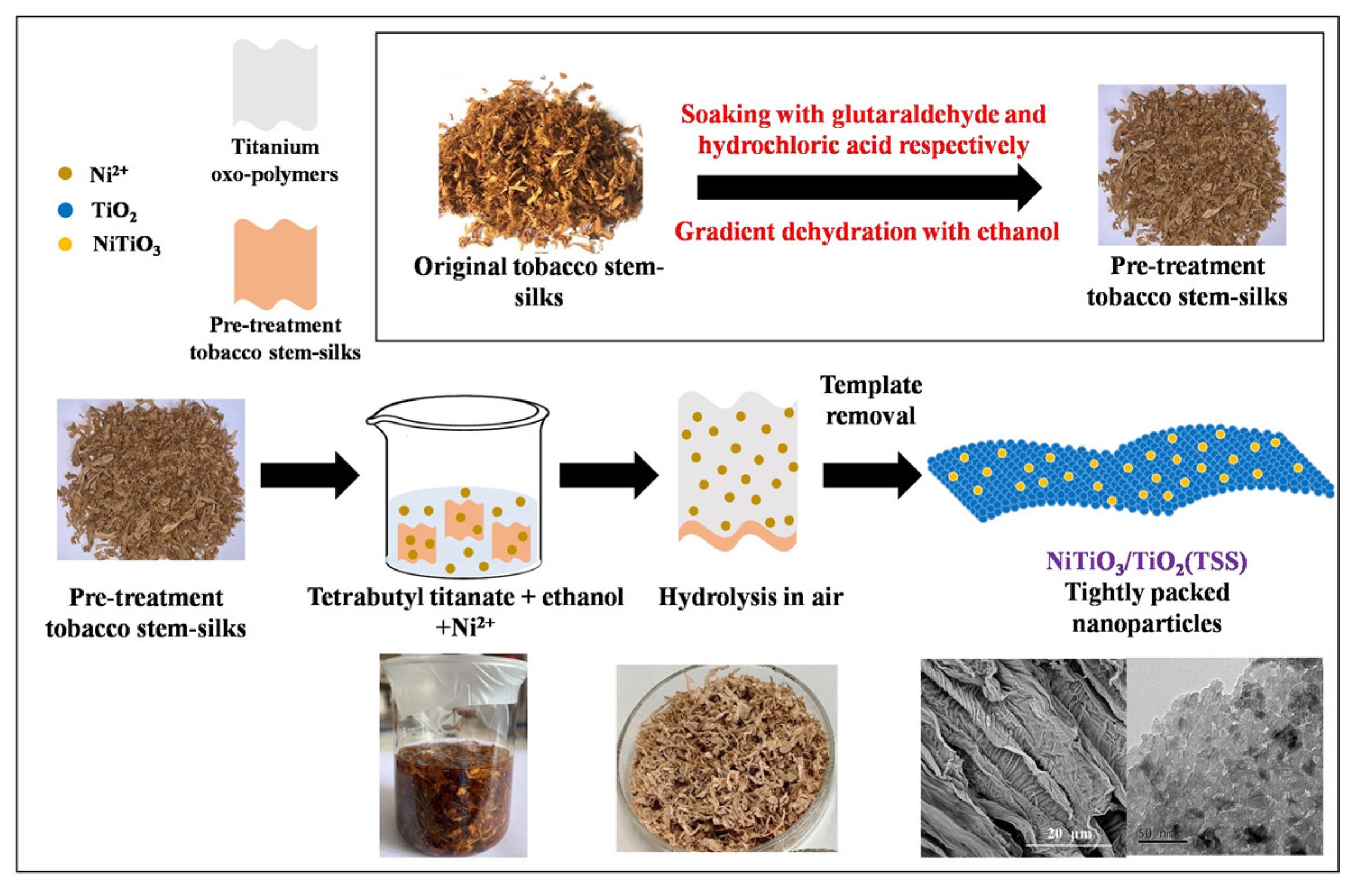
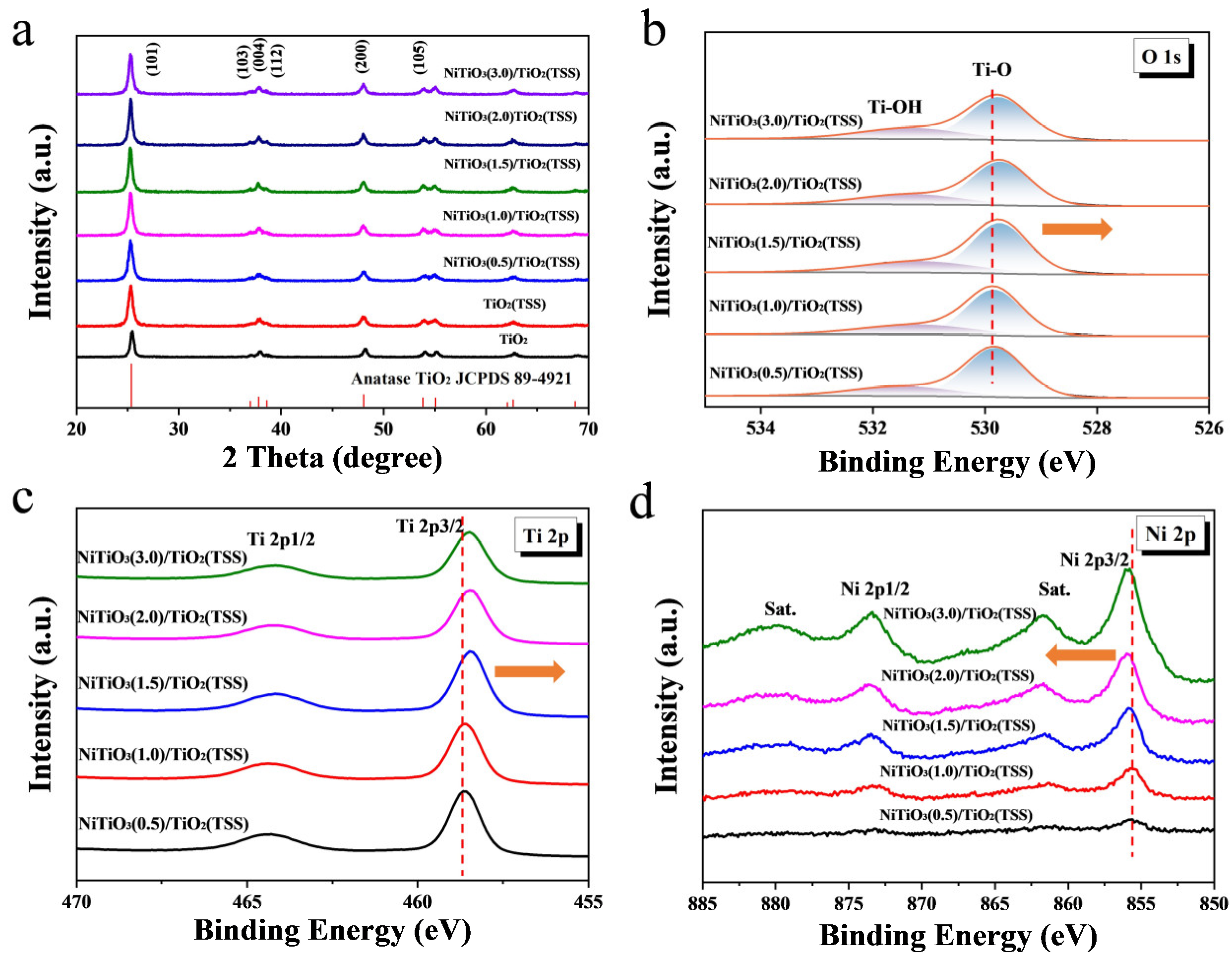
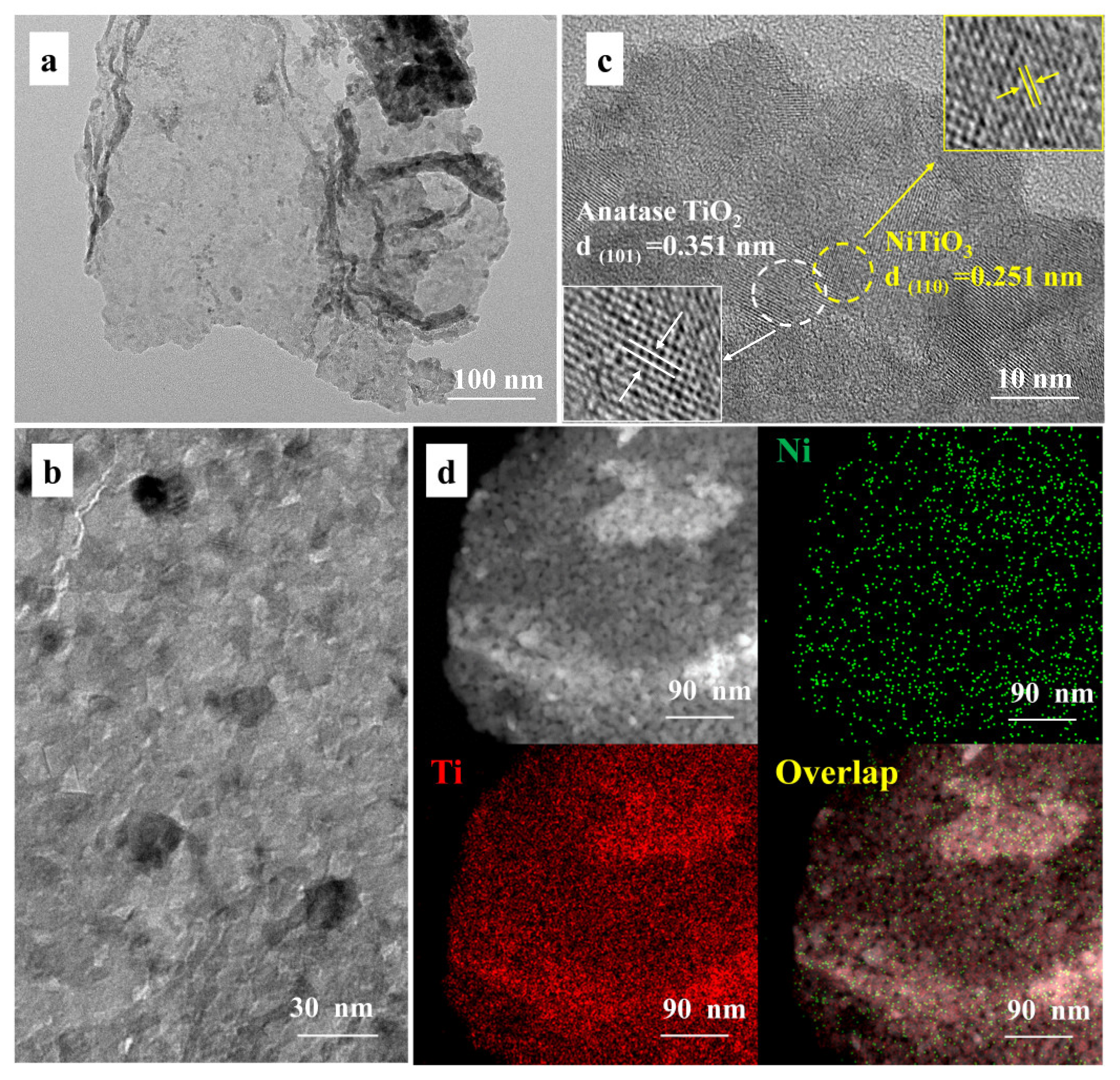


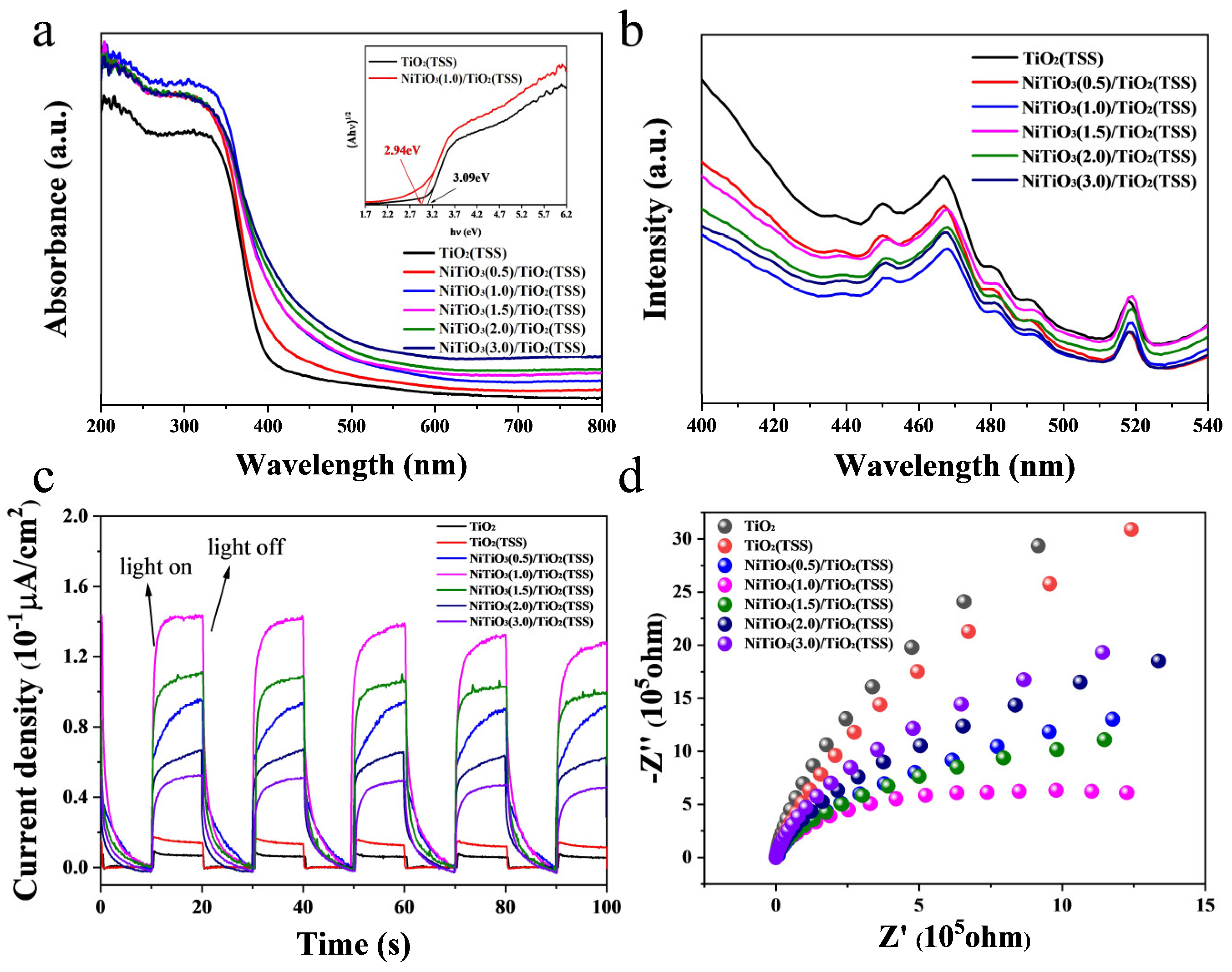
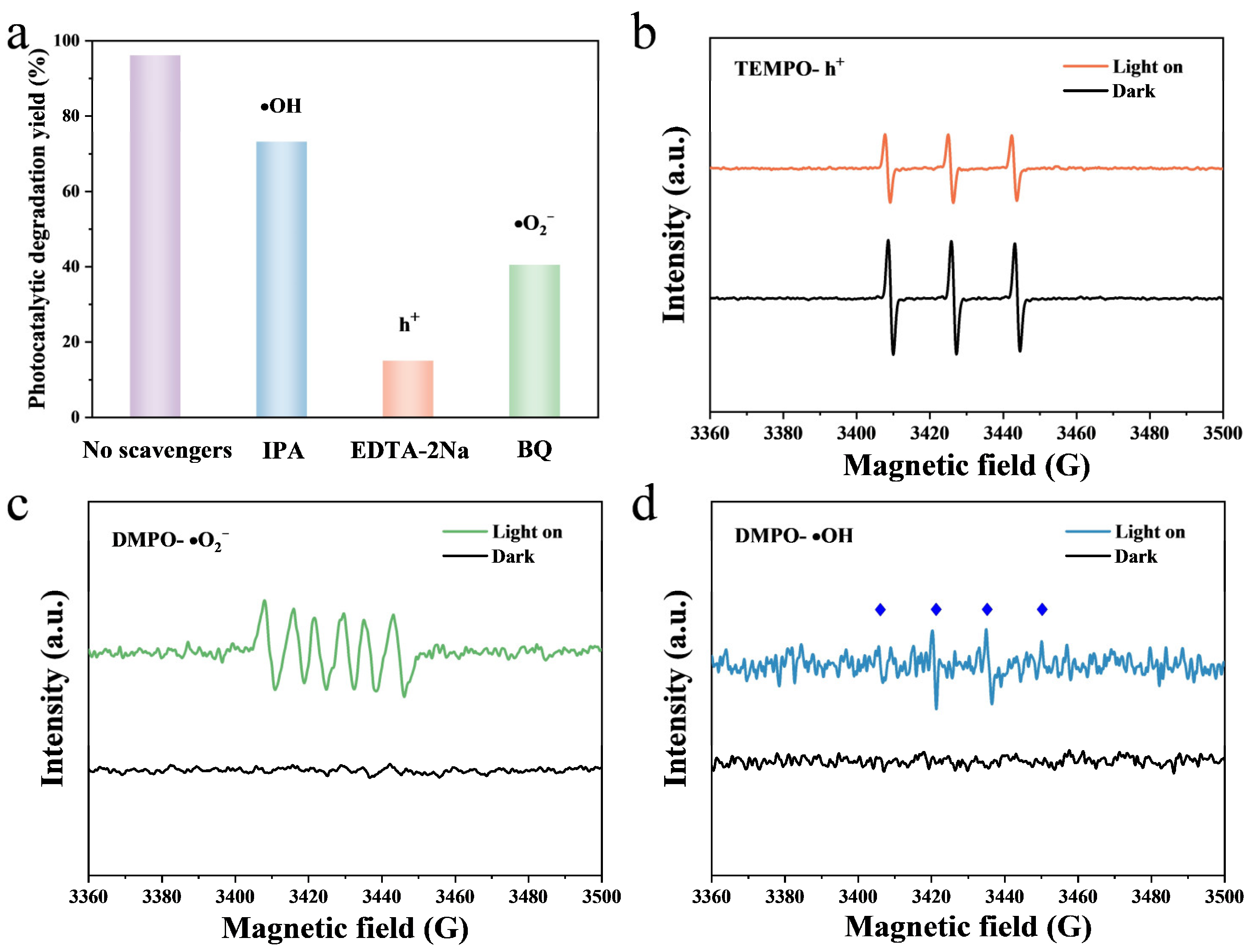
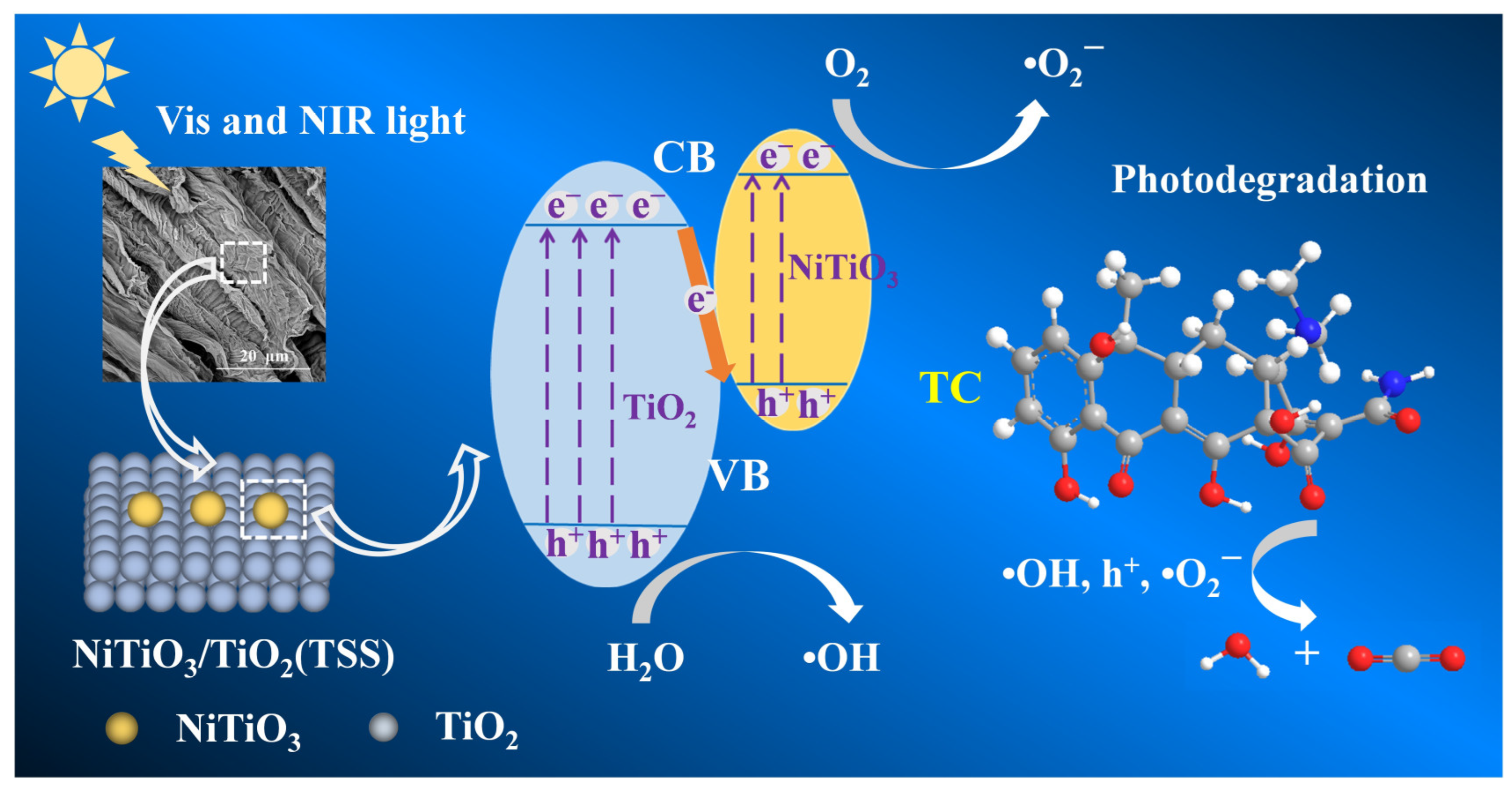

Disclaimer/Publisher’s Note: The statements, opinions and data contained in all publications are solely those of the individual author(s) and contributor(s) and not of MDPI and/or the editor(s). MDPI and/or the editor(s) disclaim responsibility for any injury to people or property resulting from any ideas, methods, instructions or products referred to in the content. |
© 2025 by the authors. Licensee MDPI, Basel, Switzerland. This article is an open access article distributed under the terms and conditions of the Creative Commons Attribution (CC BY) license (https://creativecommons.org/licenses/by/4.0/).
Share and Cite
Yuan, W.; Chen, X.; Zhao, Y.; Fang, Y.; Zhang, H.; Chen, D.; Wang, J. One-Pot Synthesis and Enhanced Vis-NIR Photocatalytic Activity of NiTiO3/TiO2 Templated by Waste Tobacco Stem-Silks. Nanomaterials 2025, 15, 80. https://doi.org/10.3390/nano15020080
Yuan W, Chen X, Zhao Y, Fang Y, Zhang H, Chen D, Wang J. One-Pot Synthesis and Enhanced Vis-NIR Photocatalytic Activity of NiTiO3/TiO2 Templated by Waste Tobacco Stem-Silks. Nanomaterials. 2025; 15(2):80. https://doi.org/10.3390/nano15020080
Chicago/Turabian StyleYuan, Weidong, Xiaohong Chen, Yi Zhao, Ying Fang, Han Zhang, Daomei Chen, and Jiaqiang Wang. 2025. "One-Pot Synthesis and Enhanced Vis-NIR Photocatalytic Activity of NiTiO3/TiO2 Templated by Waste Tobacco Stem-Silks" Nanomaterials 15, no. 2: 80. https://doi.org/10.3390/nano15020080
APA StyleYuan, W., Chen, X., Zhao, Y., Fang, Y., Zhang, H., Chen, D., & Wang, J. (2025). One-Pot Synthesis and Enhanced Vis-NIR Photocatalytic Activity of NiTiO3/TiO2 Templated by Waste Tobacco Stem-Silks. Nanomaterials, 15(2), 80. https://doi.org/10.3390/nano15020080






